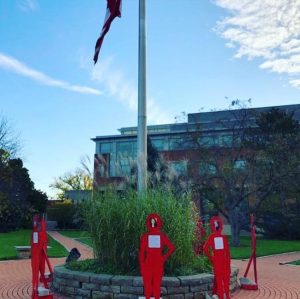AU participates in Silent Witness Project of Ashland County to spread awareness of domestic violence
Photo courtesy of the Safe Haven of Ashland
During the month of October, the Silent Witness Project was presented around the Ashland community and on AU’s campus in locations such as the quad and Ferguson Field.
November 20, 2018
The Silent Witness Exhibit visited Ashland University during the month of October, which is National Domestic Violence Awareness month.
According to the National Domestic Violence Hotline, on average 24 people per minute are victims of rape, physical violence or stalking by an intimate partner in the United States.
In a partnership between Title IX committee at AU and Safe Haven of Ashland, the Silent Witness Exhibit was set up around campus.
The Silent Witness Initiative started in 1990 and is now in all 50 states and in 23 countries. The initiative is promoting and educating in support to end domestic violence through community-based exhibits.
The Silent Witness Exhibit is a visual representation consisting of life-sized red laminated silhouettes of the women, men and children murdered in acts of domestic violence during a specific period of time within each state, county or city.
“It is very important that people understand the consequences of domestic violence,” Anna Chitteden, student rep from Title IX committee, said. “It is known as a vicious cycle where the cycle starts and eventually it progresses into the victim. The end of the cycle is death for the victim if they do not get out of it.”
The exhibit presented nine silhouettes, each one of them representing a victim of domestic violence. Eight out of nine of the victims honored in the silhouettes were murdered in Ashland County due to domestic violence since 1970.
The silhouettes were around Ashland during the month of October, but for one week the ‘It’s On Us’ combined the silhouettes located on many places around the campus such as on the Quad and in front of the stadium.
The red cutouts with the pictures of the victims are made to create a certain feeling in the viewers’ minds.
“I had a couple of people who are like, ‘wow those things are creepy. I don’t really like looking at them,’” Chitteden said. “Good! That is the point. You should not be able to look at them and be like oh, well. It is designed to make looking at them uncomfortable.”
Safe Haven Advocate Kaitlynn Dolezal said that domestic violence is not only the physical abuse.
“There are so many forms of domestic violence that may or may not be understood. A lot of people see physical abuse and think it’s domestic violence, but it is also psychological abuse, financial abuse and emotional abuse,” Dolezal said. “Domestic violence is not about hurting or hitting someone. It is about power and control.”

Cut outs of murdered women, men, and children due to domestic violence could be seen displayed on the campus quad.
Falling into an abusive relationship would be easy if red flags are ignored, Dolezal said.
“It is important to remember that it is not just individual red flags. It is usually a whole combination of multiple things that you can look for,” Safe Haven representative, Alison Webb, said. “Keep watching and keep your eyes open, and you might be able to spot a lot more things that do not seem exactly right, and you can open a conversation to see if there is a bigger problem.”
Getting out of abusive relationships can be hard and challenging for the abused ones. They feel their choices are limited, Webb said.
“The moment that someone knows, then it becomes something bigger and they fear their partner is going to find out, and then something else is going to happen, something more severe,” Webb said. “I often think survivors who are in a relationship and do not plan on leaving, do become really good at hiding things. It is important to keep in contact with friends that are in a relationship that you might think there is something going on.”
Some people try to hide that they are being abused or they are in a toxic relationship because they fear for their life. They are not in control with anything in the relationship and are in a weak place, Webb said. They think it is not a big deal and they get used to it.
“Sometimes, they love their partner, so they want the relationship to continue, but they just want the abuse to stop,” Webb said.
‘It’s On Us’ campaign encourages people to be more involved and act when they see something wrong or raise a red flag.
“I think the important thing is when you see something, say something,” Dolezal said.
If you see the signs of domestic abuse you can call Safe Haven’s 24-hour hotline at 419-289-8085 or you can stop by their offices and talk with a representative anytime.
Safe haven also offers shelter for people who are fleeing from violent relationships or unsafe situations and they have a therapist that can meet occupants in a community space. They also have support groups that meet on Monday nights.
Anyone who is facing any challenges such as violence, relationship violence or stalking, Safe Haven advocates on campus with offices in the Rhinehart building.
For more information about Safe Haven of Ashland, visit: https://www.safehavenofashland.org or check out their facebook page at: https://www.facebook.com/RCDVSafeHaven/


